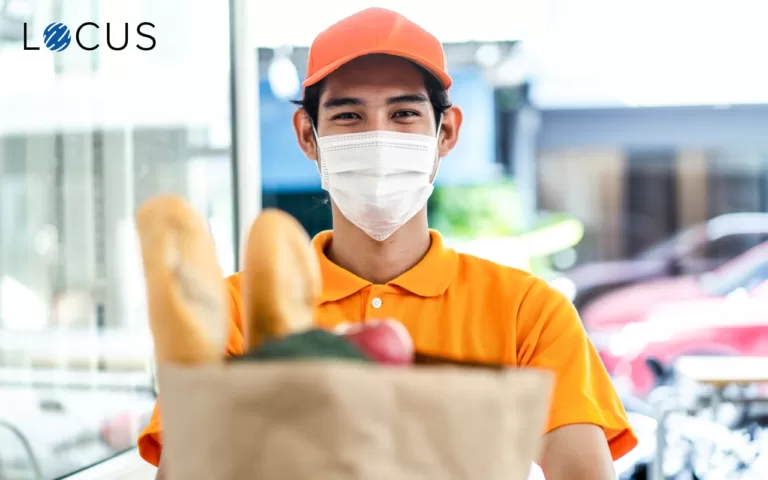Last Mile Delivery Optimization
COVID-19 Last-Mile Logistics Roadblocks: Preparing for a Better Future
Sep 17, 2020
7 mins read

Like it or not, we’re sailing through one of the worst years in the history of mankind. The Coronavirus pandemic has been a true test of our adaptability, resilience, and the ability to bounce back— as humans, as economies, and as businesses.
In his interview with Yahoo Finance during the early stages of the pandemic, Warren Buffet said, “There will be interruptions, and I don’t know when they will occur, and I don’t how deep they will occur, I do know they will occur from time to time, and I also know that we’ll come out better on the other end”.
Well, various kinds of interruptions have certainly been felt across nations, geographies, and business sectors throughout the year. From country-wide lockdowns to travel restrictions, and closing down of all but essential services, we have been through it all.
While the majority of the world’s public was confined to the safety of their homes during the larger chunk of the year, there are those who have been working day in and day out, tirelessly to ensure that people are not only safe at home but also comfortable, with everything essential accessible to them at fingertips.
As easy as it is for customers to place orders on a smartphone, it is not a cakewalk to ensure safe, contactless, and timely delivery of these orders, especially during uncertain times like these. E-commerce companies, delivery executives, and logistics enterprises have been at a constant battle with the COVID-19 crisis, fighting the many hurdles coming their way, trying to fulfill the rising demands and expectations of consumers, sitting in their homes.
Change is the Only Constant in Last-Mile Delivery. Download E-Book!
COVID-19 Last-Mile Problems Faced by Logistics Businesses
Sudden and Uncertain Demand Surges
As in-store retail operations stopped abruptly, and people were restricted to remain indoors, most consumers before turned online to buy essentials, groceries, consumer goods, and food. The COVID-19 scare also triggered stockpiling behavior among consumers, leading to unusually high order volumes.
Companies operating in E-commerce, distribution, and logistics fulfillment saw sale volumes like never before, almost similar to peak season sale levels, but this time unannounced. Handling such colossal delivery orders requires prior planning, demand estimates, and proper allocation of resources. During the early months of the pandemic, even the biggest brands in E-commerce struggled to cater to this sudden spike in orders, leading to unusual delays in deliveries.
Inventory Management Setbacks
Due to the unpredictable and dynamic buying behavior of customers, demand forecasting and inventory management went for a toss, especially for retail and consumer goods businesses. To add to it, there were other last-mile logistics challenges like limited availability of finished goods for distribution and warehouses located far away from delivery addresses.
Although it is a general practice to have storage houses in the outskirts, and distribute goods as per consumer demands, due to travel restrictions during COVID-19, it led to further delays in last-mile deliveries. Some businesses, however, benefited from pop-up warehouses and converting dormant store spaces into distribution centers.
On-Ground Resource Shortages
We’re living in the world of automation but still haven’t reached the era where drones carry out delivery operations. The last mile of delivery operations is completely dependent on human resources, and most businesses faced on-ground resource shortages for doorstep deliveries.
This led to a higher cost of operation for E-commerce and delivery businesses, as they had to pay more wages to on-ground resources for working under hostile conditions. Not to mention, delivery agents and riders had to be trained to comply with the new norm of contactless deliveries and safety protocols.
COVID-Zones and Restrictions
In many countries, depending on the spread of COVID-19, locations were marked as red, green, amber, or COVID-free zones. These zones came with their own set of rules for lockdowns, travel, and E-commerce deliveries. Planning delivery routes and distribution operations around COVID-zones is not so easy with human intelligence alone.
In many places, even after lockdowns were lifted, delivery agents were restricted to enter societies and apartments, to prevent further spread of the virus. This led to confusion and chaos among on-ground executives, causing delayed and missed delivery cases.
Last-Mile Visibility Problems
Many logistics businesses still depend on manual processes to monitor on-ground delivery activities, such as communicating with riders through calls or SMS. But, these are unprecedented times, and businesses have faced problems in handling high order fleets, managing driver performance, and ensuring timely deliveries due to a lack of visibility in last-mile operations.
Lack of visibility makes it difficult for logistics managers to supervise riders and track unproductive activities such as idle time or exceeding break hours. At the same time, the customers’ demand for complete transparency in last-mile operations has increased due to the pandemic, as they expect every order to be delivered with the utmost safety standards.
Logistics Tech: Solving Last-Mile Problems
The pandemic has exposed a number of weaknesses in logistics and supply chain management, across retail, E-commerce, on-demand deliveries, home services, and 3PL businesses, to name a few. But Artificial Intelligence and logistics tech has kept supply chains intact, even amidst the COVID-19 chaos and disruption. Logistics SaaS solutions have helped businesses scale up as per market dynamics, ensuring seamless last-mile delivery operations and maximum customer satisfaction.
- Route Planning and Dispatching – Helps logistics managers plan daily dispatches within minutes and automates last-mile route planning while taking into account real-time on-ground restrictions, traffic congestions, etc.
- Territory-Based Routing – Simplifies high-order density management, zone-based route planning, and preference-based rider allocation, ensuring smooth deliveries across multiple zones.
- On-Demand Resource Allocation Software – Assigns delivery duties to the right riders and delivery/service agents for the right activities in real-time, with minimal human intervention.
- Time-Slot Management – Allows companies to offer preferred delivery slots to customers. This helps logistics managers to plan daily and even hourly dispatches in a more efficient manner.
- Electronic Proof of Delivery – Enables delivery agents to capture delivery confirmation on their mobile devices, ensuring contactless delivery, and last-mile customer satisfaction.
- Real-time Fleet Tracking – Allows logistics managers to monitor on-ground operations closely, communicate better with riders, and take preventive measures in case of deviation from planned delivery schedules.
- Live-View Dashboards – Makes it easy to manage hundreds of riders spread across various locations and handle high volumes of tasks efficiently and accurately, with a single-screen view of last-mile operations.
Enabling customer satisfaction through smart logistics. Download Case Study!
Preparing for a Better Future
Things are crawling back to normalcy now, but if you look back at the past few months, the pandemic has taught us some valuable business lessons.
- One, that the trends in online shopping and omnichannel selling that have emerged during the year are here to stay, even after COVID-19 is gone from our lives.
- Two, digital is the new normal, just like a lot of other things such as wearing masks and using sanitizers. Businesses that cannot scale up and adopt tech in day-to-day last-mile operations could fall behind in the days to come.
- And three, agility and flexibility are essential for building resilience against future catastrophic events like the ongoing pandemic.
Locus offers a range of AI-powered logistics solutions, bringing more efficiency, consistency, and transparency in supply chain operations. Get in touch with our experts and optimize your last-mile logistics with Locus now.

Related Tags:

Last Mile Delivery Optimization
Optimizing Last-Mile Fulfillment for FMCG Businesses in the Middle East
In 2019, Bain & Co. predicted that the retail industry in the Middle East and North Africa (MENA) is on the verge of a pivotal shift. “E-commerce is becoming a reality,” the management consulting company stated, “reinventing consumers’ path to purchase, forming new customer experiences, disrupting business models, and creating growth opportunities for large and […]
Read more
3PL
How to address real-time courier dispatch challenges?
The consumer’s demand for faster, trackable, and efficient dispatch delivery is increasing. This rising demand has posed many challenges for the courier dispatching industry, especially in courier dispatch. What is a courier dispatch software? A courier dispatch software is a tool that a fleet manager uses to assign jobs to drivers. It is designed to […]
Read moreMOST POPULAR
EDITOR’S PICKS
SUBSCRIBE TO OUR NEWSLETTER
Stay up to date with the latest marketing, sales, and service tips and news


COVID-19 Last-Mile Logistics Roadblocks: Preparing for a Better Future